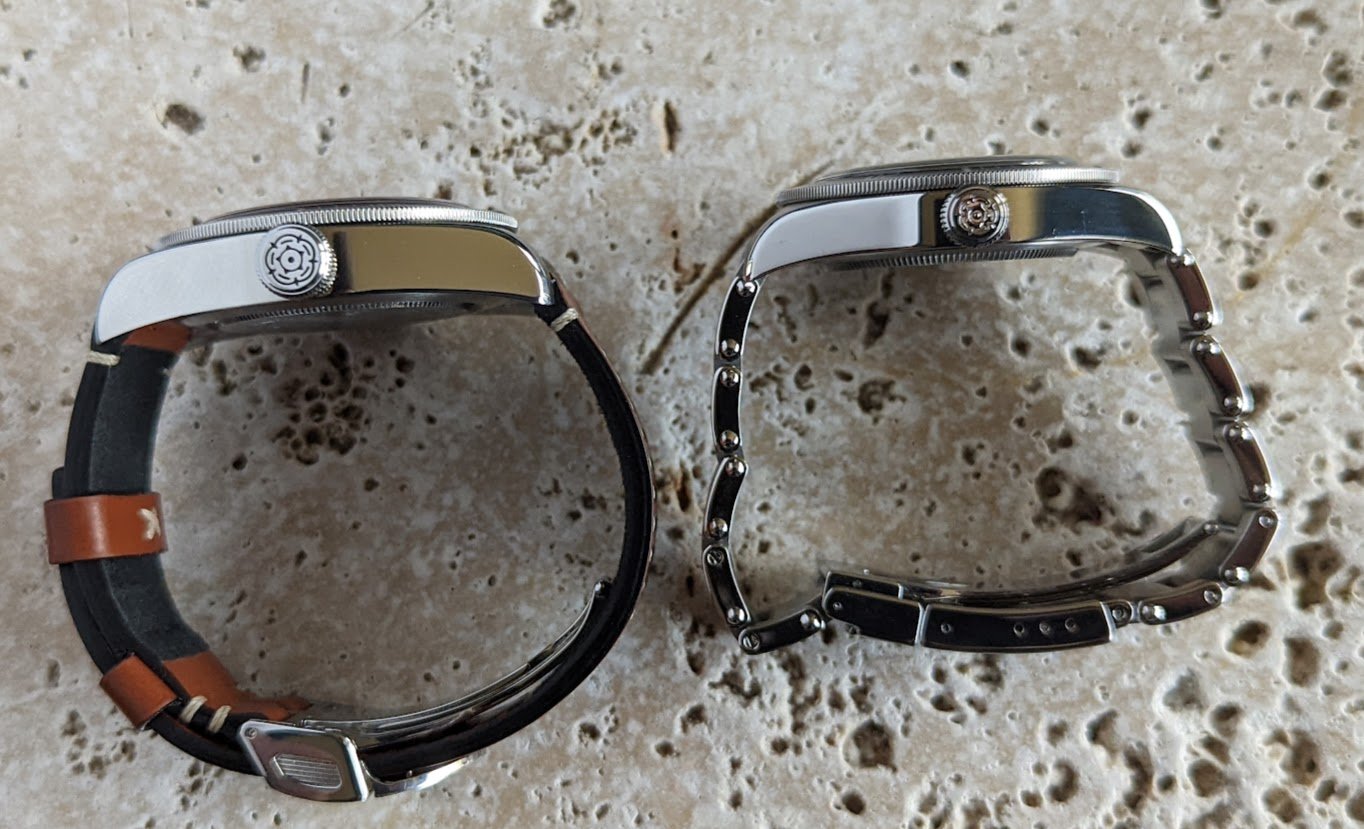A Tale of Tudors
Once upon a time, in 1954, Tudor released the Submariner, a dive watch destined to live in the shadow of a watch by the same name manufactured by Tudor’s sister company, Rolex. The Submariner was produced by Tudor until its swan song, the 79190, debuted in 1999.
The year is now 2022, and two watches sit before me, similar yet distinct. Both are modern Tudor dive watches with serious specs. The first is a first edition Black Bay Heritage 79220R “Smiley” released in 2013 (after the line debuted in 2012). It gets its nickname from the curved text at the bottom of the dial that resembles a smile. The other watch is a 2021 Black Bay Fifty-Eight 79030B. It doesn’t have a cute nickname. Maybe I’ll call it Blueberry.
On the surface of it, they’re both Black Bays, modern reincarnations of the Tudor Submariner. Both watches feature Tudor’s distinctive, love-them-or-hate-them snowflake hands and applied indices. Both have aluminum bezels with lumed pips at 12 o’clock, and both feature a large, easy-to-operate crown featuring Tudor’s historic rose logo. The case shapes are nearly identical, and the casebacks are similarly unadorned.
So why do they feel and wear so differently? Size obviously comes into play. The Fifty-Eight is a 39mm watch, so named for its more historically accurate proportions. The Smiley on the other hand is a 41 mm watch that, frankly, wears much larger.
There are other distinctions between the two that give them dramatically different characters. While the Smiley was available with a bracelet, mine is on a brown leather strap. It’s a great strap, supple and luxurious. The clasp is distinctive and beautifully machined. That said, between the strap and the gilt dial, it feels dressy, almost formal, which conflicts with its size and ungainly profile.
The Fifty-Eight is available on a bracelet or a hybrid leather-silicone strap. The bracelet is one of the finest I’ve worn: nicely articulated with brushed finishing, a great clasp, and three micro-adjustment positions. It would be nice if it featured an on-the-fly micro-adjustment system similar to Rolex’s, but you can’t have it all. The bracelet’s only objectionable feature is the inclusion of fake rivets which, while clearly intended to evoke the Oyster bracelets of yore, feel out of place and cheapen the look. That doesn’t change the overall feel and quality of the manufacturing, but it did give me pause.
Much has been made of Tudor’s snowflake hands, and I admit that there I am only a recent convert, having previously scoffed at their exaggerated proportions. Now I find them charming. Go figure. On this particular model the name “snowflake” is apt. Against the blue dial, the white lume plots on the applied hour markers really look like new-fallen snow, and the effect is quite enchanting. Combined with the silver printed dial text and matching minute track, this is a very cool, almost chilly dial.
That effect is quite contrasted by the warmth of the Heritage. The gilt hands and markers burn against the matte black dial, matched by printed dial text in a warm bronze. The dark red bezel also exudes warmth and when paired with that brown leather strap the whole watch has an almost earthy feel to it. Perhaps that’s why the old rose logo on the dial works so well here, a design choice I so wish had been carried over to the Fifty-Eight and the rest of the current Black Bay line. The shield logo, while storied in its own right, is cold and impersonal by comparison, and I’ll never be able to stop seeing it as one of those Tragedy/Comedy masks.
The other distinction on the dial is the text at the bottom of the dial. On the Heritage it is simple and again more closely echoes the vintage Submariner. The depth rating is printed above the word Rotor, beneath which are the words Self-Winding, which curve to echo the contour of the dial. This design queue is what gave the first generation Heritage line the nickname “Smiley,” a name which fits well though it makes me roll my eyes every time I use it.
The text on the modern Black Bay is much more utilitarian. Gone is the heritage-inspired reference, replaced by a Rolex-lite Chronometer designation. It’s fine, but that’s all it is.
I suppose that brings us to the movements within these watches. To many watch enthusiasts, the movement is a make-or-break factor, and the lines have been drawn here. The original Black Bay Heritage featured a third-party ETA 2824 movement like the Tudors of old, while the new one features the brand’s in-house Calibre MT5402 movement with 70-hour power reserve. To some, an in-house movement is sacrosanct, while others now covet the extinct ETA-based Black Bays. Which is better? Honestly, I don’t care, though I know that’s an even less popular opinion than picking a side here. Maybe I don’t have to because I’m holding both, but I’m still hard-pressed to say which watch I prefer.
In the end, while I wrestle with the different details in the executions, it comes down to the size. While both watches feature the same polarizing slab sides, on the Heritage they feel outsized and almost cartoonish, whereas on the Fifty-Eight they appear elegant and delicate by comparison. This is a more wearable watch across the board, and more subtle, as well, with its subdued blue and white colorway.
If I could somehow mate these watches and come away with a 39mm blue-bezel Smiley featuring the heritage rose logo, I might be in dive watch heaven. Just don’t get me started on the Harrods edition with its olive green accents. That is one of my favorite watches of all time.







